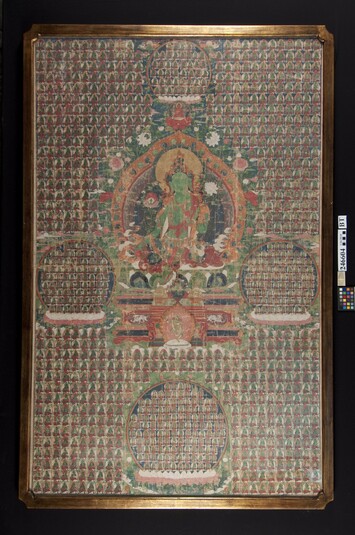
Item: Tara (Buddhist Deity) - Green
| Origin Location | China |
|---|---|
| Date Range | 1700 - 1799 |
| Lineages | Buddhist |
| Material | Ground Mineral Pigment on Cotton |
| Collection | Field Museum of Natural History |
Classification: Deity
Appearance: Peaceful
Gender: Female
Tara, Green (Tibetan: drol ma jang ku, English: the Green Liberator or Saviouress) with Amitabha above, Kurukulle below and surrounded by 1,008 small Tara emanations. (See the Green Tara Main Page and the Tara Outline Page).
Tibetan: Drol ma jang ku
Peaceful in appearance, dark green like emerald, placidly gazing forward she performs the mudra (gesture) of generosity with the right hand resting on the knee while holding the stem of a pink and orange lotus flower. The left hand held to the heart in the mudra of blessing holds the stem of a white lotus - blossoming at the left ear. Adorned with a tiara of gold and jewels, long black hair piled on the top of the head - some falling loose across the shoulders, earrings, necklaces and bracelets, she wears silk garments of various colours. Atop a moon disc, green-blue lotus seat and lion supported throne she sits in a relaxed posture with the right leg extended resting on a small lotus cushion, surrounded by a nimbus of radiant light ringed with gold and wishing jewels. Accenting the head is a yellow areola ringed with blue. A red table in front displays two golden bowls of heaped grain with a black begging bowl in the center filled with myrobalan fruit.
Wreathed with green foliage, orange, pink and white lotus blossoms, the apex of the floral display surrounding Tara is crowned with buddha Amitabha on an orange lotus seat in a sphere of rainbow light. Red in colour with the hands in the mudra of meditation, he sits in vajra posture. Below, in front of the table is Vajravarahi, red, with one face and two hands holding a curved knife in the right and a skullcup in the left. Adorned with bone ornaments, she stands in a dancing posture on the left leg above a corpse, sun and lotus seat.
Completely surrounding the large central Tara are 1,008 small Taras, identical in form, with the right hands performing the mudra of generosity (without a lotus), the left holding to the heart the stem of a lotus blossom. Framed with an aureola and nimbus, alternating in colour, each figure sits above a white flower seat, all neatly arranged in rows. In each of the four directions are large rainbow spheres containing groups of Taras seated on large pink lotus flowers. In the sphere above are 47 Taras, below 127 Taras, at the left and right 78 Taras each. 350 Taras occupy the upper sides and 328 the lower sides.
Jeff Watt 3-99 [updated 7-2010]
(There are three almost identical known paintings like the one above. The others belong to the Rubin Museum of Art in New York, the Hahn Foundation Collection in Korea and, the third, a private collector in the United States. Each painting appears identical except for the deity directly beneath the large central figure of Tara. For the Rubin painting the deity is Kurukulla, for the Hahn Collection painting it is Shri Devi Magzor Gyalmo, and for the Field Museum it is Vajrayogini (Varahi). The details of the U.S. private collection painting are currently unknown). Jeff Watt 5-2009
Subject: Composition - Repeated Figures Main Page
Collection of the Field Museum of Natural History (Painting)
Painting Set: Green Tara 1
Collection of the Field Museum (Best of Collection)
Buddhist Deity: Tara (Repeated Figures)

